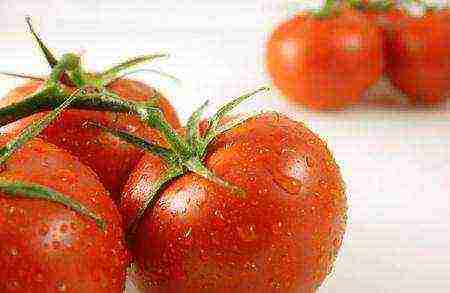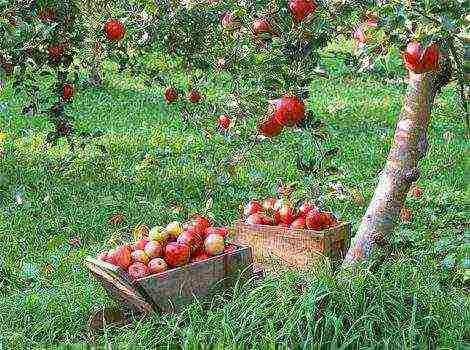(+ care tips)
The owners of six hundred square meters always have the same question: how to combine business with pleasure? After all, I would like to have both fruit trees and decorative ones. And there is not enough space ... So hazel is just what you need! Even ordinary varieties with green leaves look very elegant on the site. Especially in autumn, when their crowns are painted in all sorts of shades of yellow and red. And then there are varieties with purple leaves!
In addition, the fruits of this shrub are very tasty and healthy: they are the most nutritious of all nuts and even more nutritious than fish and meat!
In general, such a plant should be on every site.
10 varieties for the middle laneAt the moment, 19 varieties of hazel (hazelnuts) are listed in the State Register of Breeding Achievements. Nine for the southern regions. And the other ten are displayed just for the middle lane.
Academician Yablokov. A very beautiful variety with red leaves. Bushes up to 3.7 m high. Productivity is high - 4–5 kg per bush. Taste rating - 4.5 points (out of 5).
Ivanteevsky red. In summer, he also has red leaves, but in autumn they ... turn green. Bushes up to 4.5 m high. One plant can collect 1–2.2 kg of nuts. Tasters estimate their taste at 4 points.
Kudrife. A variety with beautiful pinkish-red leaves. Bushes 3.5 m high. Productivity - 1.5-2.8 kg. Taste - 4.5 points.
Moscow early. This variety also has red leaves. The bushes are low, up to 3 m. Productivity is up to 3 kg per plant. Taste rating - 4.5 points. Moscow ruby. A very decorative variety - the leaves and even the shells of the fruit are bright crimson. Bushes are high, up to 4.5 m. Productivity - 3 kg per bush. Taste score - 4.3 points.
It is the main pollinator for other varieties of hazelnuts.
Firstborn. The leaves of this variety are red. Plants up to 3.5 m high. Productivity is high - 4–5 kg per bush. Taste - 4.5 points.
It is a good pollinator for red-leaved hazelnut varieties.
Purple. Its name fully reflects the color of the leaves - they are dark purple in color. Bushes up to 3.5 m high. Up to 3 kg of nuts can be harvested from one plant. Taste rating - 4.6 points.
It is a good pollinator for hazelnuts with green leaves.
Sugar. One of the most beautiful hazelnuts - both the leaves and the nut wrappers are colored dark cherry. Bushes 3–3.5 m high. Productivity - up to 3-4 kg per plant. Taste - 4.5 points. In terms of oil and sugar content, it surpasses all other varieties!
Tambov early. It is the only cultivar for the middle lane with green leaves. The height of the bush is up to 4 m. Productivity - 4 kg per plant. Taste rating - 4.5 points.
Confession. This variety has red leaves in summer, and turn green by autumn. The bushes are low, only 2.5 m. Up to 3.5 kg of nuts can be harvested from one tree. Their taste is excellent - tasters give them 4.8 points. This is the most delicious hazelnuts for the middle lane!
Planting SecretsIt is better to plant hazel along the borders of the garden plot according to the scheme: 4x4 or 3x3 m.The planting holes are dug 80 cm wide and 50 cm deep.However, there is one little trick: it is useful to add a little soil taken from under the old hazel into the hole - in it there are special mushrooms that live on the roots of hazel. They will help a young plant to take root in a new place faster.
Ideal hazel seedlings should have 2–4 branches 30–50 cm long and a good lobe of roots. Before planting, they are pruned to 25-30 cm. The branches are shortened to 20-25 cm.
After the pits are covered with earth, the plants are watered - 2 buckets each. And the trunks are mulched with peat or humus with a layer of 3-5 cm.
Care TipsHazel is very fond of moisture, so the first year it must be watered once a week - 2-3 buckets per bush. And be sure to weed out the weeds, otherwise they will clog the young plants. The trunk circles at this time should be constantly mulched.
By the way, the roots of hazel are located superficially, so loosen the ground very carefully, no deeper than 5–8 cm.
Under young bushes, once every 3 years, they bring in a bucket of humus.
Under fruiting plants every 2-3 years (in the fall for digging) add: half a bucket of humus or compost, 4 tbsp.tablespoons of double superphosphate and 1.5 tbsp. tablespoons of potassium salt. And in the spring, before bud break, 2 tbsp is poured into the trunk circle. tablespoons of ammonium nitrate or urea.
Form a hazel bush in 6-10 trunks. And at the age of 20 they begin to rejuvenate: 2-3 old trunks are cut annually, and new skeletal branches are formed from strong young shoots.
IMPORTANT!
In order for the hazelnut to give the maximum yield, it is necessary to plant 3-4 varieties side by side. And among them there must necessarily be at least one green, because red often form only female flowers. And if male earrings do appear, then their pollen is usually sterile.
Alexey VOLODIKHIN, agronomist
Hazelnut fruits, possessing excellent and nutritious qualities, stimulate gardeners to seriously start growing cultivated varieties of hazel on their plots. What hazelnuts are, and what varieties should be chosen for its cultivation in different regions of Russia, find out from the descriptions and photos presented in this article.
Brief characteristics of the plant
Hazelnut is a cultivated form of hazel. The average height of the shrub is 6 m. The crown is spreading, large foliage can be painted in green and dark red shades, which makes hazelnuts valuable as an ornamental plant. The shape of the leaves is round or oval, serrated at the edges, the tip of the leaf is elongated. Hazelnuts bloom from December to March.
Hazelnut - a cultivated form of hazel
Hazelnuts are picky about the fertility and density of the soil, they like good watering. Its root system is located quite close to the surface, so hazelnuts are often used to strengthen loose slopes. Most varieties tolerate frost well.
Attention! Since the flowers of hazelnuts are unisexual and pollinated with the help of the wind, several bushes of different varieties should be planted in order for the plant to bear fruit.
Hazelnuts are not picky about care, grows well in shaded areas. And at the same time, most varieties of hazelnuts need to be pruned annually, since due to thickening, their yield may decrease. In addition, plants over 11 years old require anti-aging pruning from time to time.
Varieties for central Russia
At the moment, about 100 varieties of hazelnuts are known, but not all of them have sufficient frost resistance to be grown in central Russia. Therefore, when choosing a variety for planting, this should be taken into account. For the middle lane, the state registry recommends:
1. "Ekaterina" - a hybrid variety of hazelnuts belonging to the category of dessert. Frost-resistant, gives stable yields. Its vigorous bush has high decorative properties: purple foliage, elongated nuts, collected in clusters of 8 pieces and painted in pink or dark crimson shades. The average weight of a nut is up to 5 g.
Hazelnut "Catalan"
Attention! The disadvantages of the "Ekaterina" variety include the difficulty of reproduction.
2. "Catalan" - Polish medium-early variety of hazelnuts, with a good yield and excellent quality of nuts. Harvesting falls at the end of September. A characteristic feature of the variety is that fully ripe nuts fall out of the shell easily.
3. "Sugary" - a hybrid form of hazelnuts with high winter- and frost-resistant qualities, fruiting with medium-sized nuts of excellent quality. The leaves and nuts are colored in a rich dark cherry hue, which makes the shrub very attractive from a decorative point of view. The average yield per bush is 4 kg. The oil content in the kernels is one of the highest - 71%.
4. "Moscow early" - an early-ripening winter-hardy variety of hazelnuts, producing up to 3 kg of nuts from a bush, is recommended for cultivation in the northwest and central part of Russia. The weight of the nut is 1.8 g, the shape is rounded-oblong.
Hazelnut "Masterpiece"
5. "Masterpiece" - A vigorous, early-growing variety of Ukrainian origin. It can be used as a standard crop. Winter hardy and productive, easily propagates vegetatively.Large nuts are collected in bunches of 2-8 pieces, weight of 1 nut - 3 g. Kernels contain 65% oil and have good keeping quality.
Varieties for the southern regions of the Russian Federation
When cultivating hazelnuts in the south of Russia, the following varieties have shown themselves favorably:
1. "Adyghe" - due to the ability to tolerate drought and low temperatures sufficiently, it is recommended by the state register for cultivation in the Krasnodar Territory and Kabardino-Balkaria. The variety is universal, practically not affected by pests and diseases. The fruits are round, up to 2.1 g in size, collected in clusters of 3-4 pieces, the average yield is 22 c / ha.
2. "Roman" - Italian large-fruited variety of medium ripening. Cultivated in Adygea and Krasnodar Territory. The bush is vigorous, begins to bear fruit early, the harvest period falls in the second half of August.
Hazelnut "Adyghe" is resistant to droughts and low temperatures
Attention! Hazelnuts of the "Rimsky" variety, due to their low resistance to frost, can freeze out in cold winters.
The average weight of the nut is 2.7 g, the kernel is large, with a high oil content (67%), and is versatile in use.
3. "Perestroika" - an early ripe variety of hazelnuts with the highest tasting score - 5 points. Nuts are large enough, round, weighing 2.2 g, contain 73% fat.
4. "Khachapuri" - Georgian variety, characterized by stable fruiting, is capable of producing up to 20 c / ha. It is a self-fertile variety with good pollination; it begins to bear fruit at the age of 7. Resistant to pests and drought, forms a lot of shoots. Ripens in August. Nuts are large, weighing 2.7 g, have a thin shell and a kernel with an almond note in taste.
Attention! Among the disadvantages of the hazelnut variety "Khachapuri" should be highlighted low frost resistance, low rooting rate of the shoots and the tendency of the kernel to dry out during long-term storage.
Hazelnuts can be grown for decorative purposes as a hedge
Hazelnut as an ornamental plant
Since, in addition to the ability to bear fruit, hazelnuts also have valuable decorative qualities, it can be used to create decorative fences or walls, planting at intervals of 50 cm. Recommended varieties:
1. "Aurea" - tall shrub (up to 6 m) with a dense umbrella-shaped crown. When blooming, the foliage of this variety has a golden yellow color, changing in summer to lemon green, and in autumn to yellow. Variety "Aureya" - fruiting, grows well, when planted in open, not shaded areas.
2. "Kontorta" - a slow-growing shrub with high decorative properties. The trunks are strongly curved, they look especially impressive in early spring, when hazelnuts are blooming. Flowers - hanging earrings, leaves - asymmetric, strongly wrinkled, fruits - nuts of a round or oblong shape. Recommended for single plantings in open areas, to maintain decorative appeal, requires a monkey.
Hazelnut "Purple"
3. "Purple" - mid-early variety, showing high resistance to drought and frost. The average yield is 6 c / ha. Foliage - dark purple hue, fruits - oblong, small. Tasting assessment of nuts - 4.6 points.
4. Red Majestic - decorative fruiting variety of medium size. The bush trunks curved in the form of a corkscrew look spectacular in the autumn-winter period. The variety is no less beautiful in early spring, when purple-red earrings appear on it, and then the foliage of the same shade blooms. In summer, the leaves turn from purple to green. Fruits are small and not numerous.
The description of the presented varieties will allow gardeners interested in growing hazelnuts to orient themselves among the abundance of decorative and high-yielding species of cultivated hazel, to choose the best option.
Hazelnut varieties - video
.
Hazelnut is a cultivated plant that you can easily grow in your own garden.The shrub is prized for its decorative appearance and the tasty, healthy nuts that it brings regularly.
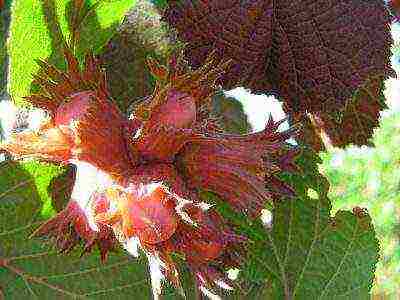
Hazelnut is a cultivated plant that can be easily grown in your own garden
Over the years, breeders have bred hazelnut varieties, among which there are winter and disease resistant, high and low, with large and small fruits. In Northwest Russia, varieties that can withstand low temperatures and sudden frosts are especially popular.
Moscow Rubin
Moscow Rubin is a red-leaved hazelnut from the selection of R.F. Kudasheva.
It appeared in 1957. The mother tree is the Nottingham hazelnut, known for its large fruits under a fragile shell. The shrub was pollinated with a mixture of pollen from various hybrid varieties bred by A.S. Yablokova. Description of the variety:
- Nuts are larger than those of the parent variety, weight 3–3.5 g. 7–15 fruits are formed in the seed. Yields 3-4 kg of nuts per bush annually.
- Leaves and fruits are red in color, which becomes richer and brighter towards the end of summer.
- The harvest ripens in early October.
- Vigorous shrub, average height 4–5 m.
- The high winter hardiness of the tree allows it to be grown in the northwestern and other cold regions of Russia.
- Hazelnut Moscow Ruby is one of the best pollinators among red-leaved shrubs.
Academician Yablokov
Red-leaved hazelnuts, bred in 1961. It is included in the list of varieties recommended for cultivation in the north-western direction of Russia, as well as in other northern regions. Mother variety: hybrid 86 with small fruits. Paternal variety: Trebizond, a unique fruitful variety. Characteristics of Academician Yablokov's hazelnuts:
- Reaches an average height of 3.6 m.
- Average winter hardiness and low immunity to weevils.
- In young shrubs, male flowers are almost not formed, but nuts are tied regularly and early. In adult bushes, catkins appear, but freeze slightly due to spring frosts, there are many female flowers, they can withstand temperatures down to -6 ° C.
- Nuts are large and elongated, thin shell.
- The crop is harvested in early October. The best harvest for the variety of Academician Yablokov is obtained when pollination with Tambov late.
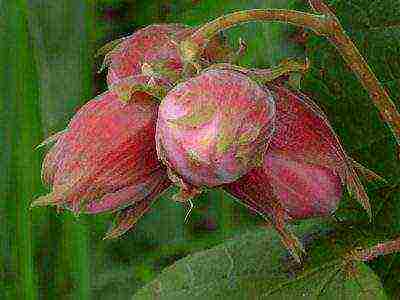
Hazelnut of Academician Yablokov has excellent characteristics
Masterpiece
Hazelnut Masterpiece - one of the best varieties of hazel from Ukrainian selection. It appeared in 1985. Its main advantages are high yield and unusually delicate dessert taste of nuts.
- The harvest ripens in August.
- The average height of the bush is 4 m, the growth is slow and poor, so the bush can be formed like a trunk.
- The first nuts are harvested when the tree is 3 years old. The nut reaches its peak yield by the 10th year of life.
- From 2 to 8 nuts grow in bunches. The fruits are large, up to 3 g in weight and up to 2 cm long. The shell is dark, pubescent.
Firstborn
Hazelnut Pervenets is a variety that is suitable for growing even in the extreme northern regions of Russia. Variety characteristics:
- Frost resistance down to –40 ° C.
- High resistance to pests, especially hazel mites.
- Sprawling shrub with powerful root shoots. The height of the tree is 3.5 m. The earrings are red in color, the bark is grayish.
- Nuts weighing 2.5 g, elongated and similar to the fruits of the Sickler variety. The shell is golden, smooth and thin. In fruit stems from 2 to 5 nuts.
- Bears fruit annually, yielding 6 kg per bush. The walnuts are harvested in September.
- One of the best pollinators for red-leaved hazelnut varieties.
The firstborn is recommended for cultivation throughout Russia, especially in the northwest direction.

Hazelnut Pervenets is recommended for cultivation throughout Russia
Variety selection
Hazelnut varieties are varied but not versatile. One shrub may be ideal for planting in northern areas, while another does not tolerate frost and dies quickly because of it.
In Russia, many varieties can bear fruit, most of them are winter-hardy. With hazel, accustomed to a warm cloudless climate, it is more difficult: only in some regions of the country can it be grown.When choosing a variety, first of all, pay attention to the level of its winter hardiness and the climate in your area.
There are both male and female flowers on the hazelnut. The wind carries pollen from male earrings to female ones, which look like kidneys. Among the varieties, there are few self-pollinating ones, so it is recommended to plant several trees, but not all pollen will work.
When choosing seedlings of different varieties, first make sure that they are compatible with each other. It is advisable to select varieties that are similar to each other in the type of fruit, in terms of flowering and ripening of nuts.
Reproduction of hazelnuts
The nut is propagated in several ways. Seed propagation is one of the most difficult. A shrub grown from seed does not inherit most of the positive qualities of its variety, therefore, only breeders propagate hazelnuts in this way.
With the help of seed propagation, agronomists get new, interesting, improved varieties:
- Pick selected nuts, process them to protect them from rodents.
- Seeds are prepared for planting in 3-4 months. They are soaked in water for 5 days, dried and placed in warm sand, stirring once every 2 weeks. After this time, the nuts are briefly immersed in the snow.
When purchasing a seedling of the desired variety on the market, buy only those that have been obtained vegetatively, and not grown from seeds. Reproduction by dividing the bush and layering is the most common.
- Division of the bush: the hazelnuts are dug up and divided so that each part has shoots, and there is a lump of earth on the roots.
- Propagation by horizontal layers: select several shoots with buds and lay them in the dug grooves, then attach them there. 40 days after the appearance of the first leaves, cover the furrows with earth. Water and add layers in summer. After a year, they can be dug up, cut off from the bush and divided.
Landing
The seedling is planted on moist, fertile soil, it should not be acidic, for this it is pre-treated with lime. You can choose an uneven place for landing. In countries where hazelnuts are grown, they are planted on the hillsides. Choose the eastern, western, northern slopes, but not the southern ones.
Sun and heat can lead to early bud opening, vulnerable to sudden spring frosts. Plant your seedlings away from tall trees. Different varieties of hazelnuts are planted in the same way, but some are more capricious than others.
Hazelnuts are usually planted in early October, but it is possible in early spring.
The soil is prepared for planting six months before work: loosen, add the necessary fertilizers, flare up. The introduction of manure and compost improves the yield of hazelnuts.
Saplings are planted at a distance of 6 × 6 m. You can cut it, but the more space the tree has, the better it will grow, develop and bear fruit. A few weeks before planting, holes are dug and filled with soil, humus, superphosphate, potassium salt.
A peg is driven in, to which a seedling is later tied. Before planting, the roots are straightened, dipped in a chatterbox and lowered into the hole to the root collar. Buried, watered abundantly and mulch the ground with sawdust or other material.
Hazelnut pests
Most varieties perfectly resist diseases and pests, but with timely prevention, this threat completely disappears:
- May beetle is the main pest of hazel. Before planting a seedling, the population of the May beetle must be ruthlessly exterminated.
- Hazelnut beetle looks like a black beetle with a long mustache. Active from May to June. It lays eggs in the bark, which is gnawed by the hatched larvae. Because of this, the branches dry out, and the leaves turn yellow and wrinkle. The larvae move to other branches and slowly devour the entire bush. To protect against the barbel in the spring, all dried and damaged parts of the tree are cut down and burned. Beetles are poisoned with insecticides.
- The nut weevil lives wherever the nut grows. They are black beetles with gray hairs and a very long proboscis. They hibernate in the soil, emerge when the temperature is warm, and begin to feed on leaves. The females lay their eggs in the nuts and return to the ground. Larvae are born in mid-June. All walnut varieties are susceptible to attack by this pest, but loosening, destruction of prematurely fallen fruits and insecticides help to cope with this danger.
Subscribe Be aware of new products on our site
Hazelnuts are cultivated varieties of wild hazel or common hazel. It is a large shrub with a powerful branched root system. It grows as a multi-stemmed bush, forming many coppice shoots, which it reproduces. Hazelnut is a wind-pollinated monoecious plant. It blooms very early, sometimes at the end of January, and mass flowering begins in February-early March - before the buds open. The hazelnut fruit is a nut covered with a plyus. It is useful because of its high content of vitamins, fats, proteins, carbohydrates. Not only nuts are useful, but bark, leaves, plus.
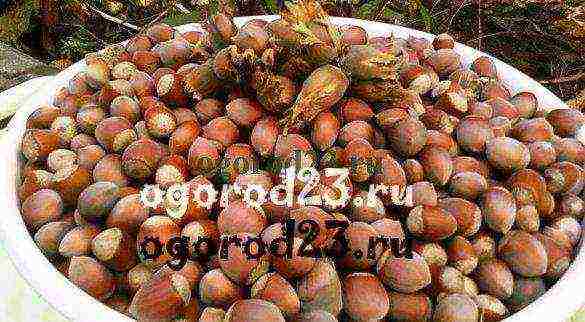
↑ to content ↑ The benefits of hazelnuts
Hazelnuts are tasty, healthy, nutritious. They contain 65-73% fats (oils), 18-22% proteins, 2-5% carbohydrates (starch and sugars). There are vitamins A, B, C, D, E, mineral salts. This determines its high calorie content as a food product. In terms of calorie content, hazelnut kernels surpass pork by 1.5 times, soybeans - 1.8 times, wheat bread - 3.5 times, beef - 3.8 times, chicken eggs - 4.5 times, potatoes - 8.5 times, apples - 15 times. For reference: 350-400 g of nuts satisfy the daily nutritional requirement of an adult.
The hazelnut kernel contains all twenty amino acids, from which complete proteins are formed. It retains its taste during storage even under normal room conditions. Nuts are easily absorbed by our body, no matter how they are cooked. This is an unsurpassed high quality product.
Hazelnuts have a lot of vitamin C in the roots and plyus of hazelnuts. Leaves and roots contain tannins.
In folk medicine, hazelnuts (hazelnuts) are used for urolithiasis, a decoction of dried plyusa - for diarrhea, bark - against fever, leaves - as an antiseptic.
Walnut, pounded with water, is used for coughing up blood, flatulence, bronchitis, and fever.
Chopped walnut mixed with honey is recommended for anemia, rheumatism.
A decoction of hazelnut bark, collected in spring, is used for malaria.
Walnut oil is an antihelminthic agent (for ascaris).
Crushed fruits mixed with egg white were used for burns.
Not only hazelnuts are useful. The bark has astringent, anti-dysentery, antipyretic properties. Bark infusions are used for varicose veins, varicose ulcers, and tumors.
Hazelnut leaves (hazel) are used to treat intestinal diseases, anemia, vitamin deficiency, rickets. Broth - with prostate hypertrophy. Ointment for cancer. Powder from dried plyusky or decoction of shells and plyusky - for colitis.
In early spring, beekeepers often harvest hazelnut or hazel pollen to feed young bees. This pollen is very useful for people: these herbal male genital products contain a lot of zinc, which is part of many enzymes that help solve the problem of infertility, making sperm motile.
↑ to content ↑ Healing properties of hazelnuts
And here are some popular recipes.
↑ back to contents ↑ Jaundice
Dry fresh leaves of hazelnuts or hazel. Pour one teaspoon of leaves crushed to a powdery state with a glass of white wine, leave overnight. Divided into three portions, taken daily before meals in three divided doses. After two weeks, the jaundice disappears.
↑ back to contents ↑ Varicose veins
- Collect hazelnut leaves in May. Pour 0.5 liters of boiling water over two tablespoons of leaves, leave for 2 hours.Drink half a glass 4 times a day before meals.
- Pour 0.5 liters of boiling water over one tablespoon of chopped hazelnut bark, cook for 10 minutes, drain. Drink half a glass 4 times a day before meals.
↑ back to contents ↑ Adenoma
Dry the hazelnut leaves collected in June in the shade. Pour one tablespoon of chopped leaves with a glass of boiling water. Heat in a water bath for 15 minutes. Drink 1/3 cup a day.
↑ back to content ↑ Biological features
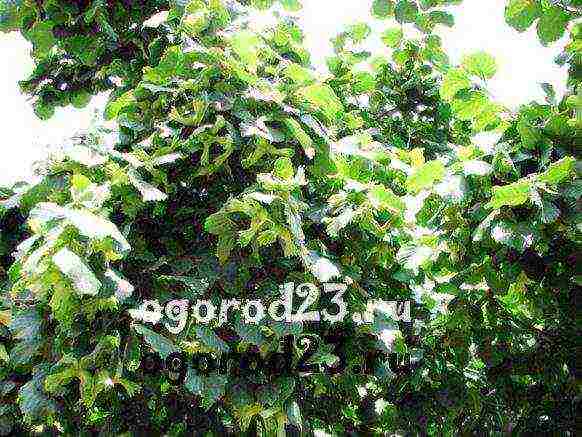
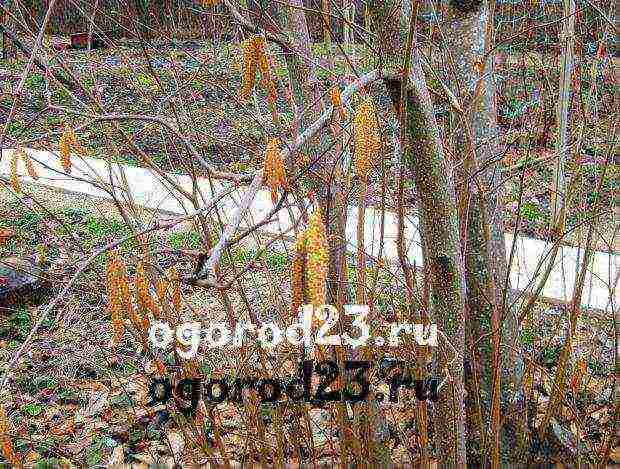
Hazelnut in February It is a relatively winter-hardy plant. We, in the Krasnodar Territory, did not notice freezing of hazelnut wood, although in the lowland areas there was frost damage to male inflorescences. When propagated by seeds, the plant does not retain the properties of the mother plant, and fruiting with this method of propagation occurs late.
Hazelnuts bear fruit well on sufficiently fertile soils provided with moisture. These can be flat areas or slopes. The southern slopes are not very suitable for growing it, since the buds here wake up too early - they can be damaged by recurrent frosts. Waterlogged, swampy areas are unfavorable for him. Hazelnuts grow well on light soils.
 The fruit of a hazelnut is a nut covered with a wrapper - a plyusa. The mass harvest takes place at the end of August and the beginning of September. An indicator of the physiological maturity of the fruit is the browning (yellowing) of the wrapper - plushi and the loss of individual nuts.
The fruit of a hazelnut is a nut covered with a wrapper - a plyusa. The mass harvest takes place at the end of August and the beginning of September. An indicator of the physiological maturity of the fruit is the browning (yellowing) of the wrapper - plushi and the loss of individual nuts.
The need for hazelnut fruits is very high. The yield of nuts from one bush with a high agricultural background is 5-12 kg, in rainfed (arid) conditions on arable land - 3-5 kg, on unproductive - 2-3 kg.
In my country house, I collected a bucket of nuts from one bush in a good year.
Hazelnuts begin to bear fruit from 3-5 years with vegetative propagation, from 6-10 years - with seed. The greatest yields are obtained when it reaches the age of 12-35 years.
A hazelnut bush annually forms a large number (up to 100-150) of zero basal shoots. To obtain a high yield, the number of basal branches (trunks) must be maintained at the level of 8-10, but no more than 12 pieces per bush.
The longevity of the bush due to the intensive formation of rhizome growth is practically unlimited. In general, hazelnuts are immortal. Almost the life span of the bush is 150-180 years, without rejuvenation of the trunks - 60-80 years.
Thus, hazelnut bushes can live in one place for a very long time. But the soil is gradually depleted and compacted: diseases and pests accumulate; the regenerative ability of plants decreases (the ability to form new zero shoots). A decrease in yield, drying of skeletal branches begins at the age of 20-25 years, and with irrigation, 5-10 years later. In the first case, the rejuvenation of the bush begins at 20, and in the second - at 30 years old. During rejuvenation, the root branches (trunks) are replaced alternately, as they dry out, growing from the shoots instead.
Scientists have experimented a lot to increase the yield of hazelnuts. The decision did not come immediately. They began to plant seedlings every 1-2 m in a row. Then only those plants were left in which branches were naturally inclined downward. The rest of the plants were cut out. The lateral branches of the left seedlings were not removed, so their crown began at a height of 50 cm from the ground. The yield increased sharply to 40 kg / ha.
Probably, many experienced gardeners who have been gardening for a long time know: if a branch going up is tilted to the ground with a rope or a brick is hung on its end, the yield will increase dramatically.
↑ to content ↑ Hazelnut varieties
It is known that it is the variety that determines the level of plant productivity, the quality of the products obtained. It must be well adapted to local soil and climatic conditions. The following are considered the best varieties of hazelnuts in the south of Russia.
↑ back to content ↑ Variety "Adygeyskiy-1"
Fruits - average weight - 2.1 g, wide, round, collected in 3-4, less often in 5-8 pieces.Recommended for growing on farm, personal plots. The variety is winter-hardy, drought-resistant, fruitful. Hazelnuts of high taste. Medium resistant to pests, insufficiently resistant to bacteriosis. On the Black Sea coast, it produces from 5 to 10 kg of nuts from one bush. Begins to bear fruit in the 6-7th year after planting. The fruits ripen in late August - early September.
↑ back to content ↑ Variety "Ata-Baba"
The variety is medium-hardy. The crop gives annually. It bears fruit well. Nuts have an excellent presentation. Begins to bear fruit for 4 years. Average yield 9.5 c / ha. Universal purpose. A vigorous hazelnut bush with a spherical, slightly flattened crown. Fruits weighing 2.5-3.0 g, round, slightly elongated. The shell is of medium thickness, light brown with dark stripes. The wrapper is much longer than the nut. Resistant to major pests and diseases (except bacteriosis). The bush is very vigorous, with a rounded, slightly spreading crown.
↑ back to content ↑ Kavkaz variety
A selection variety of the All-Russian Research Institute of Floriculture and Subtropical Crops. Fruits are large, weighing 2.5 g. Feature: good separation of the nut from the cupule. It is a good pollinator. Deserves to be tested in all hazelnut cultivation zones. The shelf life of fruits under normal room conditions is up to two years.
↑ back to content ↑ Kuban variety
The variety is winter-hardy, with a high yield. Fruits are round, slightly flattened, slightly ribbed. The shell is medium, dense, smooth, slightly bumpy, shiny, with a barely noticeable bloom. Hazelnut fruits are very large, average weight - 3.5 g. Promising for cultivation in the Krasnodar Territory. Productivity - 8-9 kg from one bush (Black Sea coast). Suitable for mechanized harvesting.
↑ back to content ↑ Variety "Louise"
Promising for growing in the Kuban. Differs in increased resistance to low temperatures, regularly, bears fruit well (7-10 kg per bush). Gives nuts of high marketable, taste qualities.
↑ back to content ↑ Panaheskiy variety
Medium ripening. Fruits are large or medium-sized (2.2 g), rounded-oblong in shape. The wrapper is longer than the nut, whole, sometimes split on one side. Highly frost-resistant hazelnuts, relatively resistant to pests and diseases. The variety is recommended for cultivation in personal or farm plots.
↑ back to content ↑ Sort "President"
Distinctive features: large-fruited, simultaneous ripening of fruits, the plyus is easily separated from the pericarp, which allows mechanizing the process of collecting nuts. Grows best on the Black Sea coast.
↑ back to content ↑ Roman variety
Fruits are large, weighing 3.2-3.5 g, one-dimensional, flat-round, with a beautiful appearance. It has a high potential for annual, abundant fruiting, is slightly affected by powdery mildew, kidney mites, and is moderately resistant to bacteriosis. The disadvantages of the variety include weak winter hardiness, low resistance to fruit rot. He was twice awarded gold medals at international exhibitions.
↑ back to content ↑ Cherkesskiy variety
It is characterized by relative resistance to pests and diseases. Relatively winter-hardy, drought-resistant. Universal purpose. Hazelnuts weighing 1.6 g, broadly oval, slightly flattened, pointed. The shell is thin, brown, with slightly pronounced longitudinal stripes. The main industrial grade on the Black Sea coast. It has proven itself well among amateur gardeners.
↑ to content ↑ Hazelnut processing
The nuts are harvested when they begin to crumble. They clean them of plush, store them in tight bags
The plyuska is also dried. You can cook jam from a green young plyuska, it has a pleasant sourness, syrups that help in the treatment of scurvy, loosening of the gums, impaired blood circulation, with increased pressure.
Hazelnuts are eaten raw, dried or roasted. From them you can make nut milk... To do this, fresh kernels are cleaned, crushed, soaked overnight in water, ground in a mortar. The resulting mass is diluted with a nine-fold amount of water, insisted for 4 hours, stirring from time to time. Then they boil, filter or drain the liquid part, adding salt and sugar to taste. By the way, nut milk turns sour, gives a delicious yogurt.
To receive nut butter crushed hazelnut kernels, slightly diluted with water, heated. The heated mass is wrapped in a piece of clean cloth, placed under a screw press, under which a vessel is placed to collect oil. It is not inferior in quality to almond, it is used in perfumery, confectionery, in the manufacture of high-quality artistic paints. Walnut oil has a light yellow color, a pleasant smell, and is well absorbed by the human body. The dough with the addition of nut butter rises well, and the finished products do not stale for a long time.
Hazelnut kernels are often used to obtain vegetable cream, milk, and other products. To prepare nut cream, the kernels are peeled from shells, peels, crushed, ground, gradually adding water in small portions. The doughy mass is diluted with warm water, whipped until a homogeneous mass is formed, reminiscent of cream in taste. Store hazelnut cream in the refrigerator. Hazelnut cream is used in its natural form, it is used to prepare a delicious, nutritious cream for pastries, muffins, cakes.
Young leaves of hazelnuts are used as food for making stuffed cabbage rolls, soups and as a surrogate for tea.
The calorie content of a nut is much higher than that of beans, soybeans, raisins, figs, milk, and potatoes. Hazelnuts are widely used in the confectionery industry. Fillings for sweets and other confectionery products are made from nut flour and kernels. The cake remaining after the separation of the oil is processed for halva, chocolate, waffles.
↑ back to contents ↑ Recipes
Finally, a few recipes.
↑ to contents ↑ Nut cream for cake
Beat eggs and sugar until thick in a saucepan placed in a water bath, then cool, add pieces of butter, nut cream, grind thoroughly
Ingredients:
- eggs - 3 pcs.,
- butter - 150 g;
- sugar - 150 g;
- nut cream - 100 g.
↑ to content ↑ Nut drink
Pour the soaked, chopped nuts with water or milk for 4 hours, then strain. Bring the infusion to a boil, add salt and sugar to taste.
Ingredients:
- hazelnuts - 200 g;
- milk or water - 1 liter;
- sugar, salt - to taste.
↑ back to content ↑ Nut coffee
Fry hazelnuts, grind with a coffee grinder or mortar, add ground black coffee. Brew one teaspoon of the mixture with 200 ml of boiling water, bring to a boil, let stand and infuse. Add sugar to taste.
↑ to contents ↑ Nut tea
Boil one teaspoon of dried hazelnut or hazelnut leaves with 200 ml of boiling water. Insist 15-20 minutes Sugar - to taste.
